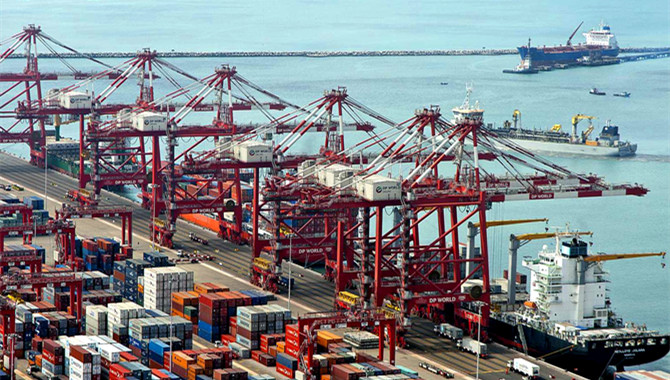A container transshipment center has been set up at China's Tancang Port, the largest port on the Yangtze River, to help relieve a global container shortage that is hampering international supply chains.
As China battles the latest wave of the COVID-19 epidemic, local governments have moved to reduce the impact of the epidemic on enterprises that rely on sea freight to get their products to market.
Throughout the epidemic, hold-ups in the transshipment of empty containers have caused a shortage of freight capacity for some exporters.
To solve this problem, Taicang Port, a few kilometers upstream from Shanghai Port, has established a sub-center to handle the transshipment of empty containers in cooperation with Shanghai, which is the world's largest port and sits at the mouth of the Yangtze River.
On Saturday, the first batch of 15,000 containers transferred from Shanghai Port arrived in Taicang.
"With the large number of empty containers transferred to Taicang Port, export enterprises can now get empty containers at the port, load them with exported goods, and send them to the port directly," said Zhang Dejun, general manager of a local shipping agency.
The establishment of the transshipment sub-center will not only ease container shortages, but also help reduce logistics costs which have increased during the epidemic.
Previously, it cost about 2,100 yuan (around 315 U.S. dollars) to get an empty 40-foot container from Shanghai's Yangshan Port and send the container loaded with goods back to the port. But now with the new transshipment center, that cost is reduced to 1,100 yuan (about 165 U.S. Dollars) and the transportation time is also cut by half.
Source: CCTV
The opinions expressed herein are the author's and not necessarily those of The Xinde Marine News.
Please Contact Us at:
media@xindemarine.com


 Ningbo Containerized Freight Index Weekly Commentar
Ningbo Containerized Freight Index Weekly Commentar  Ningbo Containerized Freight Index Weekly Commentar
Ningbo Containerized Freight Index Weekly Commentar  Ningbo Containerized Freight Index Weekly Commentar
Ningbo Containerized Freight Index Weekly Commentar  BIMCO Shipping Number of the Week: Bulker newbuildi
BIMCO Shipping Number of the Week: Bulker newbuildi  Ningbo Containerized Freight Index Weekly Commentar
Ningbo Containerized Freight Index Weekly Commentar  Ningbo Containerized Freight Index Weekly Commentar
Ningbo Containerized Freight Index Weekly Commentar